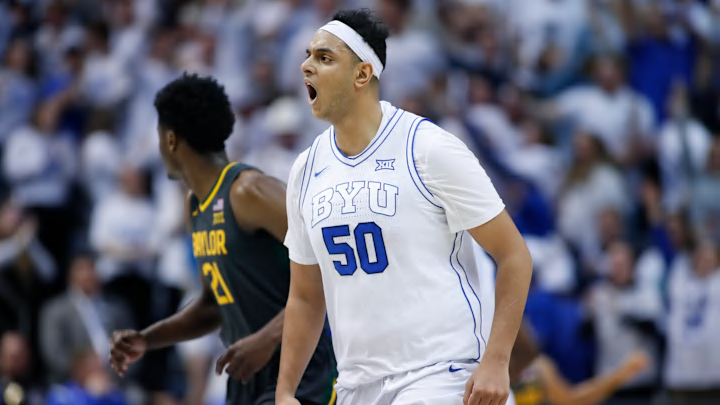When BYU snagged a transfer from Charlotte last spring, I wasn't very excited. Sure, they said he was really good and that they were excited to start utilizing him in their first Big XII season, but I doubted that this was the guy. He had impressive size that would probably help a BYU team whose starting center was 6'6", but I waved Khalifa off as just being a big body.
I was stupid for thinking that, but it seems I'm not the only person he's caught off-guard.
When Nicolaus Copernicus looked to the heavens and thought, "Hold up, I think the Sun has been the head honcho all along," he created heliocentric theory. The idea of this theory is that the planets of our solar system rotate around one center of mass, which center's mass and gravity keep the planets aligned and orbiting. Some modern NBA offenses work similarly. Players like Luka Doncic, Nikola Jokic, and (now to a lesser extent) James Harden dominate the ball, while their teammates slash, cut, and spot up in orbit of their heavy-usage star.
— Boney Fuller (@boneyfuller) February 21, 2024
In the Cougars' home win against 11th-ranked Baylor, Khalifa showed the world exactly what he was capable of. When Khalifa gets the ball at the top of the key, defenders need to start watching for off-ball movement, because if your man gets a step on you for a moment, you're a dead man. Players will use Khalifa as a screener, curling and cutting around him, finding openings in the defense, and piling on the points. If the Cougars' offense is a Japanese steakhouse, Khalifa is the Hibachi chef, tossing chunks of meat to his teammates' open mouths while dazzling with his onion volcanoes and technical wizardry.
Against Baylor, Khalifa tallied up 7 assists to go with 7 rebounds. Unfortunately for the Bears, those stats don't even tell the whole story of BYU's offensive display. While playing on a weakened knee, Khalifa is often the slowest player on the court. Defensively, he gets the job done and uses his 6'11" frame to bother his assignment, but won't amaze onlookers with his defensive prowess. The offensive side of the ball is where he makes it happen.
Players I mentioned earlier like Nikola Jokic and Luka Doncic are great comparisons for Khalifa and also bring to light a significant aspect of heliocentric basketball. The conductor of your offensive orchestra needs to be a constant threat to score the basketball. For slow-footed players like Khalifa, this means that great shooting touch is a necessity. Khalifa hit 4 out of 6 3-pointers against Baylor, and that is what makes the offense work.
BYU’s Aly Khalifa showed last night why has been listed on The Draftables since the beginning of the season.
— Adam Finkelstein (@AdamFinkelstein) February 21, 2024
Conditioning & mobility may be works in progress, but he has an extreme overlap of size, skill, passing, feel, & IQ.
Draftables: https://t.co/78kquVTSAY pic.twitter.com/9iE6IdGcS7
Adequate spacing is key for teams hoping to run through a player like Khalifa. When a distributor isn't a threat to score (much like Ben Simmons, for example), defenses feel comfortable sagging inside the 3-point arc, willing to give up space to shoot to crowd the offense, hoping to stick a wrench into the cogs of your offensive machine to shut it down. When the center of your offense is a threat to score from anywhere, defenses have to respect that by playing up on them, thus opening up the court for passing opportunities.
BYU's great season owes much of its success to the player that is often viewed as too slow, overweight, and unathletic. The Cougars like it that way. When opposing defenses underestimate Khalifa, he is happy to tear you apart and say, much like the often misunderstood Michael Scott, "Maybe next time, you will estimate me."
As AFC Richmond's Jamie Tartt pleaded with his teammates, "If we want this to work, you gotta stop going to me, and start playing through me." If Tartt's greyhound squad played Total Football, Khalifa's Cougars are playing Total Basketball through their offensive focal point.
